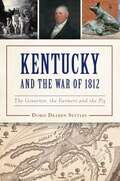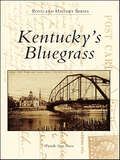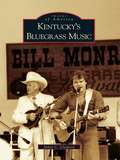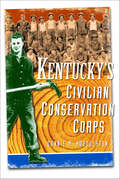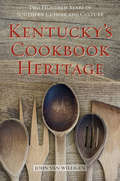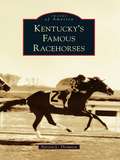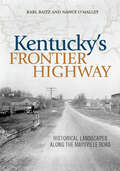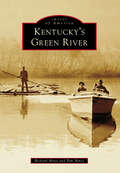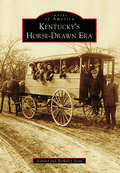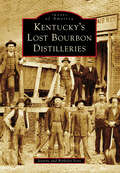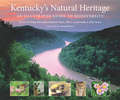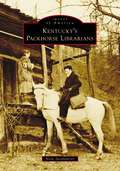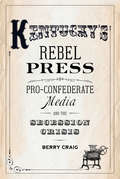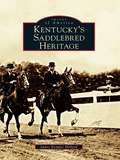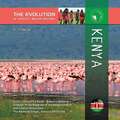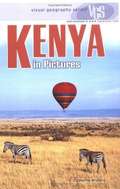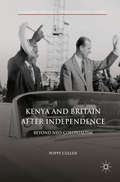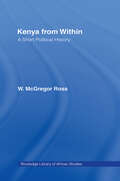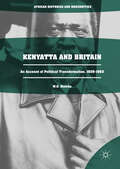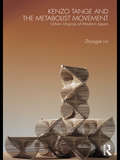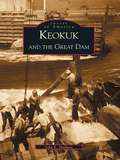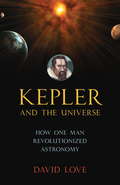- Table View
- List View
Kentucky and the War of 1812: The Governor, the Farmers and the Pig (Military)
by Doris D. SettlesHow the Bluegrass State Helped Win a War While not a single battle of the War of 1812 was fought on Kentucky soil, Kentuckians were involved to the very end. Henry Clay and his War Hawks convinced Congress and President Madison to declare war, and helped negotiate the Treaty of Ghent that ended it. After two massacres of Kentucky militia on the Northwestern front, Governor Isaac Shelby, still the only sitting governor to lead troops into battle, more than 4,000 locals and a pig marched to Canada to defeat the British and kill Tecumseh at the Battle of the Thames. Author Doris Dearen Settles explains how Kentuckians won the war of 1812 and why it is far more significant than textbooks record.
Kentucky's Bluegrass (Postcard History Series)
by Wynelle Scott DeeseWithin these pages are vintage postcards, created between 1900 and 1950, that depict an area known across the country as Kentucky�s Bluegrass. From its horse farms to its military forts and river commerce, this seventeen county region exemplifies the spirit and pride of Kentucky, and the images preserved on these postcards bring the history of this unique area to life.
Kentucky's Bluegrass Music
by James C. ClaypoolIt is likely that most fans of bluegrass music would concede that no state should be more associated with bluegrass music than Kentucky--and rightly so. Bluegrass music draws its name from the band that Kentuckian Bill Monroe formed during the late 1930s and 1940s. Bill named his band Bill Monroe and The Blue Grass Boys to honor his home state. Eventually, the music these bands and others like them were playing came to be known as bluegrass music. Later, another Kentuckian, Ebo Walker, while playing with the Bowling Green-based bluegrass band, New Grass Revival, coined the phrase "newgrass" to describe the band's progressive style of music. Other Kentuckians such as Bobby and Sonny Osborne, J. D. Crowe, Ricky Skaggs, and Dale Ann Bradley have become bluegrass stars. Some of the musicians from Kentucky covered in this book are quite famous--some are not. Famous or not, all of them have a deep-rooted passion for the music they play.
Kentucky's Civilian Conservation Corps (Vintage Images)
by Connie M. HuddlestonBy the time Franklin D. Roosevelt took his first oath of office,the Great Depression had virtually gutted the nation�s agricultural heartland. In Kentucky, nearly one out of every four men wasunemployed and relegated to a life of poverty, and as quickly as the economy deflated, so too did morality. �The overwhelming majority of unemployed Americans, who are now walking the streets�would infinitely prefer to work,� FDR stated in his 1933 appeal to Congress. So began the New Deal and, with it, a glimmer of hope and enrichment for a lost generation of young men.From 1933 up to the doorstep of World War II, the Civilian Conservation Corps employed some 2.5 million men acrossthe country, with nearly 90,000 enrolled in Kentucky. Native Kentuckian and CCC scholar Connie Huddleston chronicles their story with this collection of unforgettable and astonishing photographs that take you to the front lines of the makeshift camps and through the treacherous landscape, adversity, and toil. The handiwork of the Kentucky �forest army� stretches from Mammoth Cave to the Cumberlands, and their legacy is now preserved within these pages.
Kentucky's Cookbook Heritage: Two Hundred Years of Southern Cuisine and Culture
by John van WilligenA Southern historian combs through Kentucky cookbooks from the mid-nineteenth century through the twentieth to reveal a fascinating cultural narrative. In Kentucky's Cookbook Heritage, John van Willigen explores the Bluegrass State's cultural and culinary history, through the rich material found in regional cookbooks. He begins in 1839, with Lettice Bryan's The Kentucky Housewife, which includes pre-Civil War recipes intended for use by a household staff instead of an individual cook, along with instructions for serving the family. Van Willigen also shares the story of the original Aunt Jemima—the advertising persona of Nancy Green, born in Montgomery County, Kentucky—who was one of many African American voices in Kentucky culinary history.Kentucky's Cookbook Heritage is a journey through the history of the commonwealth, showcasing the shifting attitudes and innovations of the times. Analyzing the historical importance of a wide range of publications, from the nonprofit and charity cookbooks that flourished at the end of the twentieth century to the contemporary cookbook that emphasizes local ingredients, van Willigen provides a valuable perspective on the state's social history.
Kentucky's Famous Racehorses
by Patricia L. ThompsonCentral Kentucky is home to many magnificent horses and their farms. Although there are numerous places to witness these beautiful animals, including Keeneland, Churchill Downs, Pimlico, and Belmont, their history often gets overwhelmed by their statistics. Images of America: Kentucky's Famous Racehorses goes beyond the numbers and provides insight into the character of these beloved creatures by featuring stories straight from those closest to the horses--the grooms.
Kentucky's Frontier Highway: Historical Landscapes Along the Maysville Road
by Karl Raitz Nancy O'Malley“A remarkable historical and geographical study” of a road linking Lexington and Maysville, Kentucky, and its influence on America (West Virginia History).Eighteenth-century Kentucky beckoned to hunters, surveyors, and settlers from the mid-Atlantic coast colonies as a source of game, land, and new trade opportunities. Unfortunately, the Appalachian Mountains formed a daunting barrier that left only two primary roads to this fertile Eden. The steep grades and dense forests of the Cumberland Gap rendered the Wilderness Road impassable to wagons, and the northern route extending from southeastern Pennsylvania became the first main thoroughfare to the rugged West, winding along the Ohio River and linking Maysville to Lexington in the heart of the Bluegrass.Kentucky’s Frontier Highway reveals the astounding history of the Maysville Road, a route that served as a theater of local settlement, an engine of economic development, a symbol of the national political process, and an essential part of the Underground Railroad. Authors Karl Raitz and Nancy O’Malley chart its transformation from an ancient footpath used by Native Americans and early settlers to a central highway, examining the effect that its development had on the evolution of transportation technology as well as the usage and abandonment of other thoroughfares, and illustrating how this historic road shaped the wider American landscape.“The authors demonstrate quite convincingly that rich local history lies along our roads. They unearthed an abundance of behind-the-scenes information that is invisible to us as we barrel down the highway. It should give all readers pause to consider how much more they could know about the places they travel through.” —Craig E. Colten, author of Perilous Place, Powerful Storms: Hurricane Protection in Coastal Louisiana“A very well researched and well-written book that makes a significant contribution to the study of American roads, U.S. settlement history, and Kentucky history in particular. The authors’ approach is broad and multifaceted, well organized, and keenly focused on the myriad aspects of an important path, the land and time it transits. This is a fine holistic study of an important and complex road and its many geographical and historical components.” —Drake Hokanson, author of Lincoln Highway: Main Street across America“This notable and ably-illustrated volume . . . captures the rigors of frontier Appalachian geography and the utter ingenuity of diverse peoples bent on moving west. The road is perhaps the greatest of American themes?it encapsulates freedom, mobility, possibility, escape, commerce, crime and calumny, adventure, and romance. Thank goodness we have these two able storytellers to give us the narrative of the Maysville Road.” —Paul F. Starrs, Regents & Foundation Professor of Geography (University of Nevada), and recipient, J.B. Jackson Prize, Association of American Geographers
Kentucky's Green River (Images of America)
by Richard Hines Pam HinesNamed for Revolutionary general Nathanael Greene, Kentucky's Green River begins a 384-mile journey at its source near Kings Mountain in Lincoln County, flowing through the Pennyroyal and Western Coal Field regions until its confluence with the Ohio River in Henderson County. Throughout the 1800s, the Green River was a lifeline for valley residents, both in obtaining supplies or transporting products to cities along the Ohio River and destinations as far as New Orleans. Flatboats moved lime, coal, tobacco, and whiskey out of the valley, while rafts of logs were floated to Evansville sawmills. In the 1830s, a series of locks and dams were built on the Green River, permanently raising water levels that finally allowed larger paddle wheel steamers to begin plying upstream, transporting passengers and freight into the river's upper reaches. Referred to as the "era of steamboating," these magnificent boats were numerous until the last of the fleet, the Evansville, burned in 1931. Today, commercial towboats continue moving numerous products along the lower segment of the river, while the upper portion of the river is known as the fourth-most diverse aquatic ecosystem in the United States, making it a destination for outdoor enthusiasts from across the country.
Kentucky's Horse-Drawn Era
by Jeanine Scott Berkeley ScottImages of America: Kentucky's Horse-Drawn Era takes a look at the days when animals--mostly horses and mules--supplied the "horsepower" for daily life in Kentucky. The animals' work included hauling buggies, carriages, wagons, hearses, circus wagons, parade floats, bookmobiles, coal cars, school buses, and everything and everyone in between. This book even has a photograph of a mule team pulling a two-story house down the street of a small town in Kentucky; other unusual images feature a "high-diving" horse and the winners of the Mule Derby. These vintage photographs highlight horses and mules in some of the many roles they filled before the advent of the automobile, the pickup truck, and the tractor.
Kentucky's Lost Bourbon Distilleries (Images of America)
by Jeanine Scott Berkeley ScottKentucky bourbon is world-renowned, and the distilling of this corn-based liquor has deep roots in almost every corner of the state. Hundreds of distilleries dotted the landscape, beginning with the early settlements until 1920, when the vast majority were closed because of Prohibition. Many of the distilleries never reopened and became "lost," with only old photographs left to tell this story of dedicated craftsmanship. In some cases, distilleries reopened during a "bourbon boom" when Prohibition finally ended in 1933, only to falter a few decades later. Some of those distilleries were sold and portions of the properties, like warehouses, reused by the new owner. Despite everything, bourbon distilling remains a major industry in the state--and a world-famous icon for Kentucky. Kentucky's Lost Bourbon Distilleries is dedicated to the many people who worked at distilleries that may be "lost" but are not forgotten.
Kentucky's Natural Heritage: An Illustrated Guide to Biodiversity
by Deborah White Greg Abernathy Ellis L. Laudermilk Marc Evans“[A] beautiful book about a state that has just about everything except a beach: mountains, swamps, rivers, plains, and, of course, the lovely bluegrass.” —Baton Rouge AdvocateKentucky’s abundance of plant and animal life, from the bottomland swamps in the west to the rich Appalachian forests in the east, is extraordinary as well as beautiful. Glades, prairies, forests, wetlands, rivers, and caves form a biologically diverse patchwork that is unique to the state. Kentucky’s Natural Heritage: An Illustrated Guide to Biodiversity provides an essential reference to the remarkable natural history of the commonwealth and is a rallying call for the conservation of this priceless legacy.Kentucky’s ecosystems teem with diverse native species, some of which are found nowhere else in the world. Kentucky’s Natural Heritage brings these sometimes elusive creatures into close view, from black-throated green warblers to lizard skin liverworts. The aquatic systems of the state are home to rainbow darters, ghost crayfish, salamander mussels, and an impressive array of other species that constitute some of the greatest levels of freshwater diversity on the planet.Richly detailed and lavishly illustrated with more than 250 color photos, maps, and charts, Kentucky’s Natural Heritage is the definitive compendium of the commonwealth’s amazing diversity and presents a persuasive argument for the necessity of conservation. Organized by a team from the Kentucky State Nature Preserves Commission, the book is an outgrowth of the agency’s focus on biodiversity protection.“Between its covers, readers will find details of Kentucky’s vanished natural areas and catalogue of the increasingly rare animal, plants and unique habitats that urgently need protection.” —Louisville Courier Journal
Kentucky's Packhorse Librarians (Images of America)
by Nicki JacobsmeyerMarking the ridgelines and hearts of the Appalachians during the Great Depression, packhorse librarians delivered hope, one book at a time.When the Great Depression started, folks stumbled on hard times. Many lost their jobs and homes, and they struggled to support their families. But people craved hope for the future, and hope arrived with the packhorse librarians through Pres. Franklin D. Roosevelt’s New Deal in 1933. Each week, children, families, and schoolhouses celebrated when their packhorse librarian arrived at their doors with books. After being handled by many cherished hands, reading materials needed to be taken out of circulation. The librarians constructed scrapbooks and filled them with beloved items—recipes, quilt patterns, pictures, and stories. Challenges awaited the librarians at every pass. From muddy creeks to snowy hillsides, the packhorse librarians delivered books and hope to their patrons. Although the program ended in 1943, the lasting effects on literacy and the communities these packhorse librarians visited can still be seen today.Author Nicki Jacobsmeyer lives in rural Missouri, where she writes fiction and nonfiction for adults and children. She inspires others to discover and dream through reading and believes books are windows to the world.
Kentucky's Rebel Press: Pro-Confederate Media and the Secession Crisis
by Berry Craig“A history of Kentucky's pro-Confederate press and its decidedly unsuccessful campaign to take the Bluegrass State out of the Union.” —Civil War Books and AuthorsThroughout the Civil War, the influence of the popular press and its skillful use of propaganda was extremely significant in Kentucky. Union and Confederate sympathizers were scattered throughout the border slave state, and in 1860, at least twenty-eight of the commonwealth’s approximately sixty newspapers were pro-Confederate, making the secessionist cause seem stronger in Kentucky than it was in reality. In addition, the impact of these “rebel presses” reached beyond the region to readers throughout the nation.In this compelling and timely study, Berry Craig analyzes the media’s role in both reflecting and shaping public opinion during a critical time in US history. Craig begins by investigating the 1860 secession crisis, which occurred at a time when most Kentuckians considered themselves ardent Unionists in support of the state’s political hero, Henry Clay. But as secessionist arguments were amplified throughout the country, so were the voices of pro-Confederate journalists in the state. By January 1861, the Hickman Courier,Columbus Crescent, and Henderson Reporter steadfastly called for Kentucky to secede from the Union.Kentucky's Rebel Press also showcases journalists who supported the Confederate cause, including editor Walter N. Haldeman, who fled the state after Kentucky’s most recognized Confederate paper, the Louisville Daily Courier, was shut down by Union forces. Exploring an intriguing and overlooked part of Civil War history, this book reveals the importance of the partisan press to the Southern cause in Kentucky.
Kentucky's Saddlebred Heritage (Images of America)
by James Kemper MillardLong associated with fine Thoroughbred horses, Kentucky's Bluegrass region is also home to America's oldest indigenous breed: the American Saddlebred horse. A composite of several breeds, the Saddlebred was developed by 18thcentury colonists who sought a goodlooking, sensible, adaptable, and comfortable animal to ride and drive. These traits made it the mainstay of the Confederate cavalry during the Civil War and the choice mount of many generals on both sides. As the Industrial Revolution replaced the need for working horse power, the Saddlebred evolved naturally into recreational activities. Affectionately known as "peacock of the show ring," the Saddlebred's beauty, expression, and athleticism epitomize the essence of a show horse. In many ways, the breed's history parallels that of America and unfolds in pictures in Kentucky's Saddlebred Heritage.
Kenya (The Evolution of Africa's Major Nations)
by Jim CorriganMany anthropologists believe the human species originated in Kenya's Rift Valley, where hominid skulls more than 2 million years old have been discovered. That fact alone would make Kenya an important place. But this East African nation has many other extraordinary characteristics: diverse terrain, a remarkable variety of plant and animal life, and a fascinating blend of cultures and languages among its people. The political system in Kenya is far from ideal. Historically, government corruption has been a major problem. However, the country adopted a new constitution in 2010 and is considered one of the most stable in Africa. Kenya has a free press and multiple political parties that compete in national elections. The country has also been fortunate to escape the chaos that has affected many neighboring countries in East Africa.
Kenya In Pictures (Visual Geography)
by Catherine BrobergA brief overview of Kenya's land, history, government, people, and culture.
Kenya and Britain after Independence
by Poppy CullenThis book explores British post-colonial foreign policy towards Kenya from 1963 to 1980. It reveals the extent and nature of continued British government influence in Kenya after independence. It argues that this was not simply about neo-colonialism, and Kenya's elite had substantial agency to shape the relationship. The first section addresses how policy was made and the role of High Commissions and diplomacy. It emphasises contingency, with policy produced through shared interests and interaction with leading Kenyans. It argues that British policy-makers helped to create and then reinforced Kenya's neo-patrimonialism. The second part examines the economic, military, personal and diplomatic networks which successive British governments sustained with independent Kenya. A combination of interlinked interests encouraged British officials to place a high value on this relationship, even as their world commitments diminished. This book appeals to those interested in Kenyan history, post-colonial Africa, British foreign policy, and forms of diplomacy and policy-making.
Kenyan, Christian, Queer: Religion, LGBT Activism, and Arts of Resistance in Africa (Africana Religions #3)
by Adriaan van KlinkenPopular narratives cite religion as the driving force behind homophobia in Africa, portraying Christianity and LGBT expression as incompatible. Without denying Christianity’s contribution to the stigma, discrimination, and exclusion of same-sex-attracted and gender-variant people on the continent, Adriaan van Klinken presents an alternative narrative, foregrounding the ways in which religion also appears as a critical site of LGBT activism.Taking up the notion of "arts of resistance," Kenyan, Christian, Queer presents four case studies of grassroots LGBT activism through artistic and creative expressions—including the literary and cultural work of Binyavanga Wainaina, the "Same Love" music video produced by gay gospel musician George Barasa, the Stories of Our Lives anthology project, and the LGBT-affirming Cosmopolitan Affirming Church. Through these case studies, Van Klinken demonstrates how Kenyan traditions, black African identities, and Christian beliefs and practices are being navigated, appropriated, and transformed in order to allow for queer Kenyan Christian imaginations.Transdisciplinary in scope and poignantly intimate in tone, Kenyan, Christian, Queer opens up critical avenues for rethinking the nature and future of the relationship between Christianity and queer activism in Kenya and elsewhere in Africa.
Kenyan, Christian, Queer: Religion, LGBT Activism, and Arts of Resistance in Africa (Africana Religions #3)
by Adriaan van KlinkenPopular narratives cite religion as the driving force behind homophobia in Africa, portraying Christianity and LGBT expression as incompatible. Without denying Christianity’s contribution to the stigma, discrimination, and exclusion of same-sex-attracted and gender-variant people on the continent, Adriaan van Klinken presents an alternative narrative, foregrounding the ways in which religion also appears as a critical site of LGBT activism.Taking up the notion of “arts of resistance,” Kenyan, Christian, Queer presents four case studies of grassroots LGBT activism through artistic and creative expressions—including the literary and cultural work of Binyavanga Wainaina, the “Same Love” music video produced by gay gospel musician George Barasa, the Stories of Our Lives anthology project, and the LGBT-affirming Cosmopolitan Affirming Church. Through these case studies, Van Klinken demonstrates how Kenyan traditions, black African identities, and Christian beliefs and practices are being navigated, appropriated, and transformed in order to allow for queer Kenyan Christian imaginations.Transdisciplinary in scope and poignantly intimate in tone, Kenyan, Christian, Queer opens up critical avenues for rethinking the nature and future of the relationship between Christianity and queer activism in Kenya and elsewhere in Africa.
Kenyatta and Britain: An Account of Political Transformation, 1929-1963 (African Histories and Modernities)
by W. O. MalobaThis book is the first systematic political history of Jomo Kenyatta, Kenya’s founding president. The first of two parts, it explores Kenyatta’s formative years in nationalist activism in Kenya and Britain, the complex links between colonial and British intelligence services and Kenyatta’s career and the political compromise he forged between Kenya and Britain. This book draws on primary sources to analyze this compromise, which marked his transformation from "leader to darkness and death" to the most beloved post-colonial African leader in the West.
Kenzo Tange and the Metabolist Movement: Urban Utopias of Modern Japan
by Zhongjie LinMetabolism, the Japanese architectural avant-garde movement of the 1960s, profoundly influenced contemporary architecture and urbanism. This book focuses on the Metabolists’ utopian concept of the city and investigates the design and political implications of their visionary planning in the postwar society. At the root of the group’s urban utopias was a particular biotechical notion of the city as an organic process. It stood in opposition to the Modernist view of city design and led to such radical design concepts as marine civilization and artificial terrains, which embodied the metabolists’ ideals of social change. Tracing the evolution of Metabolism from its inception at the 1960 World Design Conference to its spectacular swansong at the Osaka World Exposition in 1970, this book situates Metabolism in the context of Japan’s mass urban reconstruction, economic miracle, and socio-political reorientation. This new study will interest architectural and urban historians, architects and all those interested in avant-garde design and Japanese architecture.
Kenzo Tange and the Metabolist Movement: Urban Utopias of Modern Japan
by Zhongjie LinAmid Japan’s political turbulence in 1960, seven architects and designers founded Metabolism to propagate radical ideas of urbanism. Kenzō Tange’s Plan for Tokyo 1960 further celebrated urban expansion as organic processes and pushed city design to an unprecedented scale. Metabolists’ visionary schemes of the city gave birth to revolutionary design paradigms, which reinvented the discourse of modern Japanese architecture and propelled it through the years of Economic Miracle to a global prominence. Their utopian concepts, which often envisaged the sea and the sky as human habitats of the future, reflected fundamental issues of cultural transformation and addressed environmental crises of the postindustrial society. This new edition expands Zhongjie Lin’s pathbreaking account on Tange and Metabolism centered at the intersection of urbanism and utopianism. The thorough historical survey, from Metabolism’s inauguration at the 1960 World Design Conference to the apex of the movement at Expo ’70 and further to the recent demolition of Nakagin Capsule Tower, leads to a definition of three Metabolist urban paradigms – megastructure, group form, and ruins – which continue to inspire experiments in architecture, city design, and conservation. Kenzō Tange and the Metabolist Movement is a key book for architectural and urban historians, architects, and all those interested in avant-garde design, Japanese architecture, and contemporary urbanism.
Keokuk and the Great Dam
by John E. HallwasThis remarkable pictorial history tells the story of an engineering marvel: the first dam built across theMississippi River (from 1910-1913), and the historicMidwestern community that fostered the world-famoushydroelectric project. Keokuk and the Great Dam is the story of a colorful and historic river town with a dream of economic development and cultural progress; a self-taught engineer who took on a challenge that no one else wanted to attempt; and a massive construction effort that pitted men and machines against the awesome power of America's greatest river. Completed shortly before WWI, the Keokuk dam (now known as Lock and Dam No. 19) was the culmination of a long struggle to employ the Mississippi River for hydroelectric power and to improve navigation on the great waterway. In frontier days the Des Moines Rapids, stretching north from Keokuk, prevented loaded steamboats from moving upriver. They also created a business opportunity for local residents. A rapidly growing town by the 1850s, Keokuk went into decline for many years when it failed to secure adequate railroad connections. But the coming of hydroelectric powerfostered a new dream, and local leaders set out to harness the great river. What followed was a dramatic effort that drew international attention, produced the world's second largest dam (at the time), and forever changed both the community and the fabled American waterway.
Kepler and the Universe
by David K. LoveA contemporary of Galileo and a forerunner of Isaac Newton, Johannes Kepler (1571-1630) was a pioneering German scientist and a pivotal figure in the history of astronomy. This colorful, well-researched biography brings the man and his scientific discoveries to life, showing how his contributions were every bit as important as those of Copernicus, Galileo, and Newton. It was Kepler who first advocated the completely new concept of a physical force emanating from the sun that controls the motion of the planets--today we call this gravity and take it for granted. He also established that the orbits of the planets were elliptical in shape and not circular. And his three laws of planetary motion are still used by contemporary astronomers and space scientists. The author focuses not just on these and other momentous breakthroughs but also on Kepler's arduous life, punctuated by frequent tragedy and hardships. His first wife died young, and eight of the twelve children he fathered succumbed to disease in infancy or childhood. He was frequently caught up in the religious persecutions of the day. His mother narrowly escaped death when she was accused of being a witch.Intermingling historical and personal details of Kepler's life with lucid explanations of his scientific research, this book presents a sympathetic portrait of the man and underscores the critical importance of Kepler's discoveries in the history of astronomy.From the Hardcover edition.
